345
230

Summer is coming. This means that for many, a long-awaited vacation with the whole family is just around the corner, for others, an equally long-awaited trip to a children’s camp, for some, picnics in nature in the company of beloved friends. Summer is wonderful because it gives hundreds of options for spending time to suit every taste.
Many types of summer recreation include being near bodies of water. Such leisure will not only give positive emotions, but will also be beneficial for the health of both adults and children.
Swimming helps strengthen muscles and joints. At the same time, the load on the spine is significantly reduced, and the water serves as a kind of protective cushion that softens any movement. As a result, the risk of injury becomes minimal.
In addition, swimming helps:
- strengthen the heart and blood vessel walls;
- increase overall tone and strengthen immunity;
- improve the functioning of the lungs and the entire respiratory system;
- increase blood supply to the brain, strengthen the nervous system.
If you are going to the beach with a child who does not yet know how to float independently, we recommend that you spend a few minutes on this article. In it, we tried to collect useful exercises and basic recommendations so that the child learns a new skill easily and without unnecessary stress for everyone.
At what age can you start teaching your child to swim?
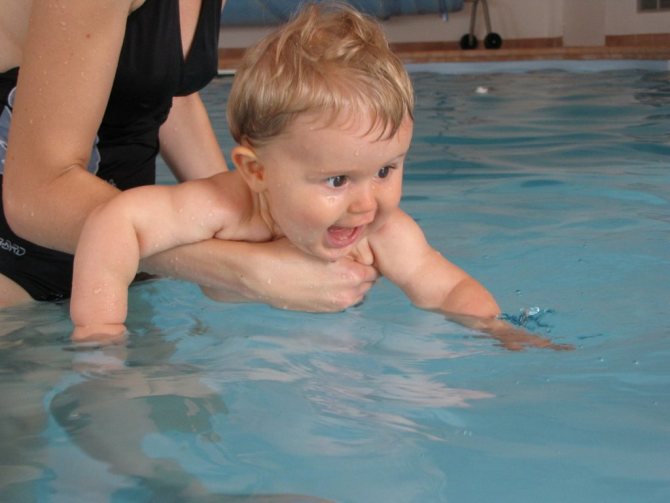
Physiologically, a child has the ability to swim from birth. While in his mother’s womb, he “swimmed” in amniotic fluid for nine months. Once born, a child can instinctively hold his breath and carry out rowing movements with his hands. There is, however, one peculiarity here: if you do not maintain this reflex during the first two months, it fades away.
In the 70s of the last century, scientists from Moscow even conducted research on this topic. Infants aged 1-2 months could easily float on water, and subsequently 80% of them demonstrated high resistance to colds.
Returning to the question of age, swimming training should begin when parents are ready for it. After all, they have to overcome difficulties together with the child and get rid of fears. On the one hand, the older the child, the easier it is to come to an agreement with him. In most cases, he himself already understands the benefits of swimming and is interested in learning.
When it comes to raising a professional swimmer, there is no point in wasting precious years. Sports trainers advise starting training at the age of 4 years. It is during this period that a natural thirst for something new and the physiological ability of the brain to quickly master coordinated movements of the arms and legs are noted.
Slip
The goal is for the child to be able to slide in the pool , stretched out like an arrow. It is not necessary to breathe at first - you can do it while holding your breath.
Let me remind you that all exercises are done exclusively in the shallow part of the pool !
Let the child push off with his feet from the bottom or wall of the pool and slide , stretching his arms forward in front of him (“arrow”). At the end of the exercise, you pick him up, or he stands on the bottom himself.
This accustoms the body to the correct position in the water and teaches how to stay on it.
How to overcome your fear of water?
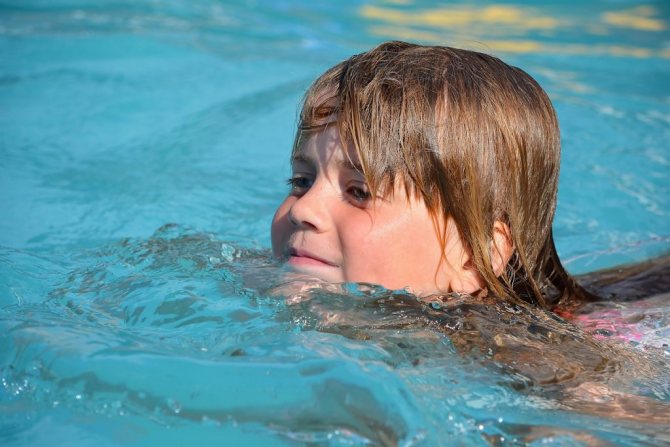
If a student is afraid of water, you should not convince him otherwise. To achieve quick results, it is important that classes take place in a comfortable and safe environment. Parents should focus not on overcoming fear, but on creating a feeling of safety. You can do this as follows:
- give the opportunity to get used to the water. When the baby looks around and is not distracted by new sensations, it is worth talking about the properties of water. In age-appropriate language, tell them that water, if the body is positioned correctly, will keep it afloat and “push” it to the surface. Show that the ball does not sink in water, explain why this happens. The absence of fear will allow you to achieve the desired result faster;
- let you feel the ground under your feet. Do not rush to immediately take the student into depth. The water level to the chest is optimal in the first stages of training. Invite the future swimmer to play games. The “Fountain” exercise helps you get comfortable in the water: bend your knees slightly so that your lips are in the water. In this position, you should blow out air with your mouth until bubbles form. This activity will certainly entertain the child and help cope with anxiety. In the future, you can go to a depth where the water level reaches the collarbones.
When teaching, it is important to remain calm, not to rush the child, and not to raise your voice. A parent should be a “lifeline”, a “guide” on the path to the unknown. When the fear of water is left behind, they begin to learn to stay afloat. You shouldn’t delay this moment, because you get used to being in the water, touching the bottom.
Stay calm and be a confident guide for your child, not only in learning to swim, but in any other situation. Always know where your child is and what is happening around him so that you can provide him with timely help or support. Download the “Where are my children” application from the AppStore and GooglePlay stores.
Swimming glasses
You need to get your child used to wearing swimming goggles. In children five years old this usually does not cause problems; in younger children, whims may arise at this stage.
Try to go through this stage in a playful way. Admire your child when he wears glasses. Explain and show that you can have fun and splash in them. Show by personal example.
If possible, it is also better to choose the glasses themselves in an interesting shape or color, but first of all they should not leak - I wrote in detail about how to choose them correctly here.
You can, of course, do without glasses at all - but then you need to choose a pool in which, if you are under water with your eyes open, there will be no unpleasant sensations in your eyes (check this for yourself first).
Swimming pool or open water?
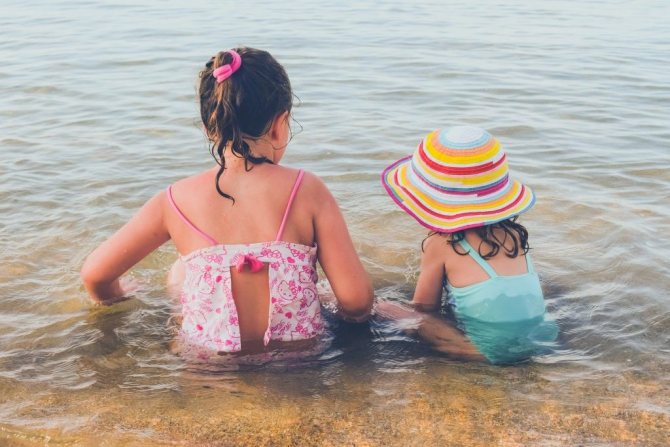
You can overcome your fear of water in the pool. There is less space, a comfortable temperature, the area is fenced - all this adds to the feeling of security. Judging by surveys of familiar parents, approximately half of children successfully master swimming in the pool. The young swimmer is not influenced by extraneous distractions (fish, stones, salt water, etc.). If necessary, you can show your child an instructor or other employee responsible for safety.
Transparent water will help the student control his movements, observe the position of his legs, and simply not be afraid of what is not visible in a muddy river. It is recommended to learn swimming in open waters at the age of at least 4 years. In any case, it is worth being guided by the situation and listening to the child’s condition.
Club "Aquademia"
Aquademia is a club for swimming children from 2 months to 6 years old near the Shchukinskaya metro station. Two full-fledged swimming pools allow you to conduct classes in different formats: trainer + baby, trainer + couple (mother and baby) and small groups (up to 4 people). The club staff includes only professional instructors and hydro-rehabilitators with specialized education and necessarily experience working with infants.
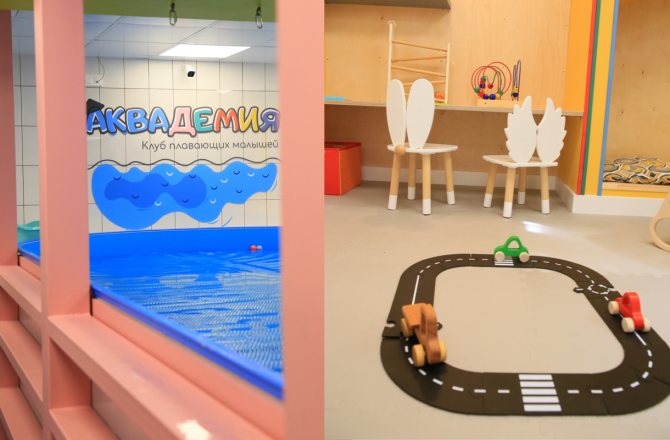
Photos of the club "Aquademia"
Water quality is a special pride of Aquademia. The temperature is maintained at 31-33C, the water goes through a triple purification system and is completely renewed in 30-60 minutes.
The gaming Aquademia is worth special attention, so visiting the club should not be limited to time spent in the pool. Children enjoy exploring exciting toys and often stay in the club for more than an hour.
Aquademia is the territory of not only children's, but also parental happiness! Parents can participate in the lesson or watch their baby on the big screen while sitting in a comfortable seating area. The club administrators carefully offer tea, coffee and lemonade.
The founders of the club approached the formation of the concept of the pool with special trepidation and great soul. The design uses not only beautiful, but also environmentally friendly materials.
The club is located at st. Academician Bochvara 3, building 3. The cost of one group lesson is 1000 rubles, individual - from 1500. A subscription for 6 group lessons costs 4560 rubles.
Basics of proper swimming in various styles
Regardless of the age at which the skill is mastered, it is important to know: the correct body position is horizontal with the face lowered into the water . It is instinctive for a person to raise his head. But a lowered face helps maintain balance and prevents the cervical vertebrae from overworking during prolonged exposure to water.
This position increases buoyancy and increases speed in any style. Therefore, when you learn “from scratch”, it is better to immediately develop the correct position, so as not to waste time and effort on relearning.
Sports swimming has 4 styles:
- Butterfly . This style is not suitable for children who are just learning. It requires great physical effort and well-functioning coordination of actions. During the movement, the swimmer “flies” over the water, making simultaneous swings of his arms and a splash of his legs, similar to the movements of a dolphin.
- Breaststroke. The arms perform wide, “spreading” movements, and the legs seem to push off from the surface of the water.
- Crawl on the chest. The fastest style: the arms make sweeping strokes, and the legs perform alternating scissor-type swings. Most of the time the swimmer's face is submerged in the water. In this case, inhalation occurs while turning the head.
- Back crawl. The movements are identical to the previous style, only the swimmer is on his back. This is a clear advantage for children who are not comfortable putting their face in the water.
If you are not raising a professional athlete, you should not immediately accustom him to a particular style. First of all, you need to practice breathing, leg and arm work.
Further development
Regardless of whether you went through the “express” option or the “academic” option, at this stage the child will not yet have developed the correct sports technique - he will simply learn to swim , but the movements will not be optimal.
Next, you need to seriously master the front and back crawl, breaststroke, and if you wish, you can also do the butterfly.
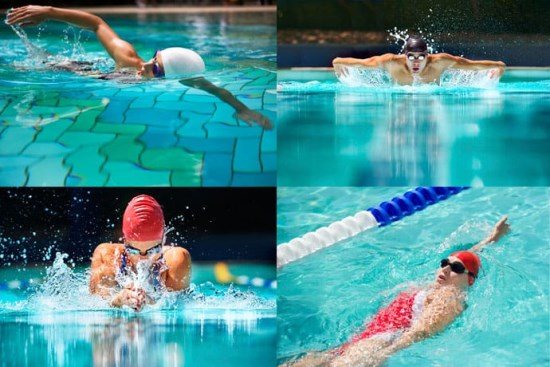
Four sports styles
I am convinced that the correct technique for these styles can only be taught by a coach or an experienced swimmer.
If you are initially targeting them, then, if possible, it is better to enroll your child in a pool section or for individual lessons with a trainer from the very beginning.
If this is not possible, then in addition to this article, I recommend that you read my articles on these swimming styles:
- crawl: technique, how to learn;
- breaststroke: technique, how to learn;
- backstroke swimming : how to swim and how to master it;
- butterfly: how to swim, training.
How to teach a child to swim?
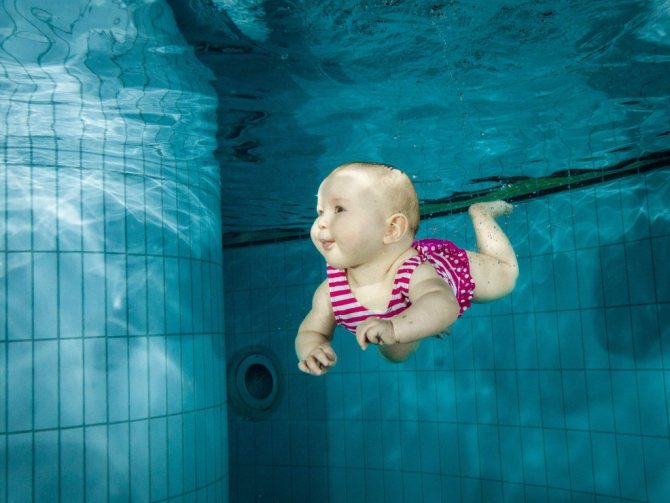
If you practice every day, it is quite possible to achieve the desired result during a week-long vacation. There are even express methods developed by experienced instructors that allow you to master basic movements within one or two days. The most important thing here is not to force things and focus on the degree of readiness of your ward.
The learning process also depends on what you want to get as a result: whether you just need to teach your child to stay afloat or immediately master the desired style. If you are inclined to the second option, professional swimmers recommend starting with the crawl.
Naturally, when selecting exercises, it is important to focus on the student’s age. Next, we will consider basic techniques that correspond to age-related physiological and psychological characteristics.
Swimming training for preschool children
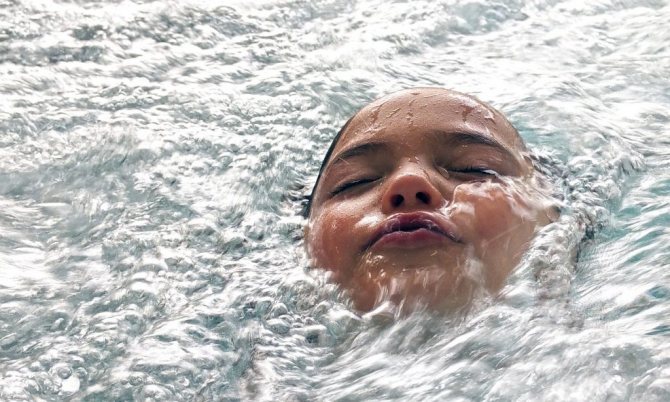
It is impossible to force a small, but already human, to swim without desire, and it does not make sense. At the age of 3-4 years, a child learns about the world through play. Therefore, in a playful way, you can instill in your baby the main skills, and the swimming technique will be practiced as he grows up.
We bring to your attention several exercises that will help you master the necessary movements:
- "Mill". Starting position: standing in chest-deep water, arms bent. You need to perform circular movements with your hands, immersing them as you lower them into the water. Here it is important to emphasize the correct order of immersion: first of all, the hands come into contact with the water, then the forearms, elbows, and shoulders.
- "Scissors". This task focuses on footwork. Holding the side or bottom with your hands (at shallow depths), the child will need to lie down on the water and alternately swing his legs up and down.
- "Jellyfish". Holding the student under the chest, ask him to lie face down in the water. The neck, legs and arms are as relaxed as possible. This position teaches you to stay afloat and not be afraid to dip your face.
- "Starfish". The body position is similar to the previous one, only the arms and legs are extended to the sides. You can complicate the task by adding exhalation into the water. If the child is not ready to lie face down, you can start the exercise from a supine position.
- "Heart". Starting position: standing, arms extended forward. Ask your child to “draw” a heart by spreading his arms to the side and bringing them together at the bottom. Shoulders and arms should be immersed in water.
- "Frog". The child holds onto the adult with his hands, moving his legs as if pushing off the water.
- "Jumping" in the water. Invite your baby to sit down and then jump, doing the previous two exercises at the same time. Be prepared to provide physical assistance (hold, catch) and psychological support to the beginning swimmer.
- "Float" . Starting position: standing. Take a deep breath and, squatting, sink to the bottom. Tell them in advance that you will need to hold your breath. As an incentive to perform, you can put some bright toy on the bottom.
Such training will help you get comfortable in the water and not cry if drops get into your eyes or nose. You can use protective equipment: glasses, a hat and other accessories to create maximum comfort for your child.
If you present training as a fun time with parents, the child will look forward to new exciting activities. By the way, such exercises provide a good psychoprophylactic effect and allow you to relieve muscle and emotional tension.
“Academic” methodology for teaching primary school children
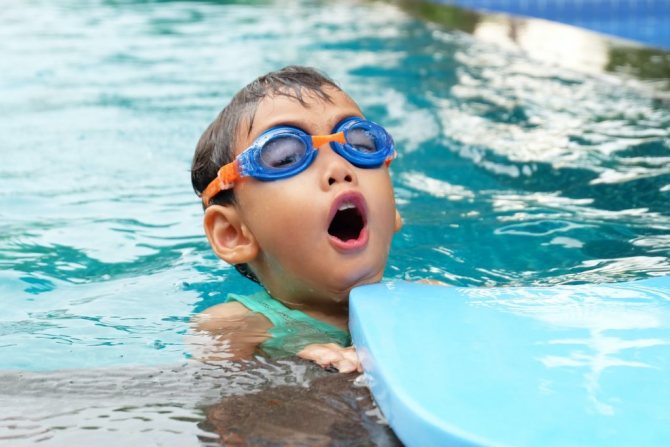
The period from 7 to 10 years is characterized by awareness in performing exercises. There is no longer any need to invent exciting activities in a playful way. The younger student is ready to learn to swim on his own initiative. Of course, parents should not forget that motivation at this age still depends on external factors. Therefore, as with children, it is important to create an atmosphere that stimulates activities, arouses interest and brings positive emotions. Use praise often and avoid ridicule.
Now let's move on to practice. Step-by-step implementation of the exercises described below is a guarantee that the child will learn to swim:
- Breathing into the water. Starting position: standing, immersing your face in the water, hands holding the handrails. In this case, you need to exhale air through your nose or mouth until a “boil” forms. Such exercises are done 10 to 15 times before starting training.
- Swimming with a board . Starting position: lying on the water, holding the board. Arms extended. The face is lowered into the water. Moving forward is carried out due to the movement of the legs. The legs work from the hip without bending at the knee. It is important to follow the breathing technique here: to inhale, lift your face up, exhale into the water. Mastering swimming with a board can take from one to several lessons, depending on your student’s readiness.
- "Arrow" . The exercise is similar to the previous one, but is performed without a board. This task is a kind of test: if the child has coped with it, then it is worth moving on to the next stage.
- Connecting hands. There may be three options:
- if the leg movements were performed in the breaststroke style, then the arm movements are performed in the same style. You will receive a “ready” breaststroke, all that remains is to hone your skills;
- if the legs moved with the crawl, “breaststroke” movements with the arms are allowed. In this case, the child will master the “doggy style” technique, which is intuitive and allowed at the initial stages;
- and the third option: legs when swimming - crawl, hand strokes - also crawl. With parallel training in sideways breathing, the child will fully master this style.
Of course, it’s too early to talk about the ideal performance technique at this stage. But the child already knows how to float on the surface of the water and move forward.
Teaching your child to swim before traveling? Be calm about him not only in the water, but also on land. To prevent your child from getting lost in a strange place, download the “Where are my children” application with the Surround Sound and GPS function from the AppStore and GooglePlay stores.
“Express option” for younger students
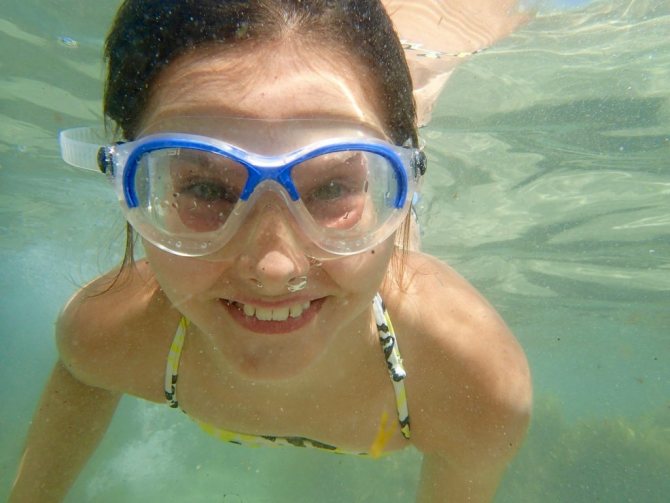
If you think the above method is too complicated or time-consuming (especially when summer is in full swing and you want to teach your child to swim freely in a matter of days), try another way. It will allow you to achieve results in a short time, without focusing on practicing the technique.
The essence of the classes comes down to several exercises:
- Starting position: lying on the water, hands resting on the bottom. Immerse your face in water 10 times and relax your neck muscles. Naturally, the exercise can only be performed at shallow depths.
- Perform the same actions with one hand lifted from the bottom of the pool.
- Perform the same actions with alternately lifting your hands off the bottom.
When the child has mastered the third task, ask him to remove both hands at once. In this way he will learn to “lie” on the water. But that's only half the story. Next you should teach him to move forward. You can do this using the following exercises:
- Starting position: lying on the water, smoothly straighten your arms forward. Remember that haste and jerking are of no use here.
- While on the water with your arms outstretched, push off the side with your feet and “slide” forward. When this is achieved, we add movements with the legs (just move them without focusing on the technique of execution). Having mastered moving with the legs, we also connect the arms without reference to the style. Let the child move them the way he feels comfortable. The only requirement: do not put your hands behind your body so that you can raise your face above the water without losing balance.
- Raising your head. At first, you should raise your head without inhaling. It is important to work out the sequence of actions. When this happens, add an inhale over the water.
This method was proposed by coach D. Tarakanov. The author claims that the desired result can be achieved in just one lesson.
Middle and high school age
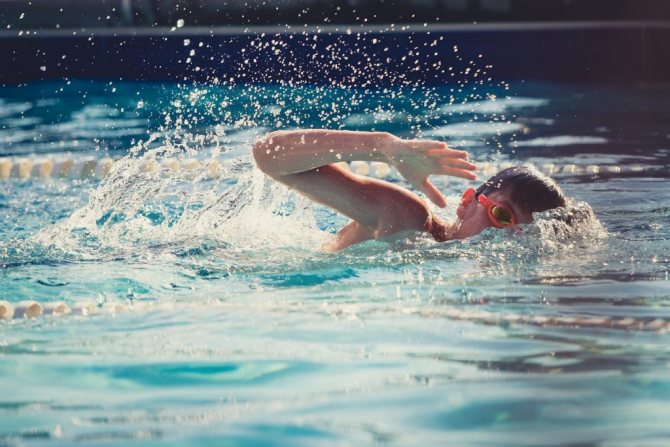
You can train a teenager using the methods outlined above. After 12 years of age, it is easier for children to complete the tasks described; they easily learn the instructions. Difficulties that arise during learning, most often, can be caused by psychological issues:
- strong fear of water (as a result of unsuccessful attempts to swim earlier);
- lack of contact with the “teacher”;
- persistent reluctance to learn.
Here the adult needs to find an approach to the older student, motivate him to acquire new skills, and demonstrate the benefits of swimming. Once a trusting relationship has been established, you can begin training.
The most important principle of study
The second important thought, which I would also like to draw special attention to: the most important thing when learning to swim at this age is the child’s joy, interest, and positivity.
The fact is that swimming lessons should be systematic (one or two times is clearly not enough!), and a child at this age is not yet a fully formed, conscious personality and is not ready to systematically do something that he is not interested in or does not like.
Moreover, proper learning to swim (and you shouldn’t teach it incorrectly!) involves actions that are not very natural for a person, such as lowering your face and exhaling into the water .
The child may be afraid and not understand this and, ultimately, may decide that he “doesn’t need” all this at all.
Therefore, if you teach it yourself, I recommend taking into account the following:
- Learning must happen in a playful way in a light, relaxed manner. At a very young age and at first games are required.

Joy is the main principle of classes - There should be no coercion or pressure . If a child does not want to study, your task is to figure out how to interest him, make him want to study, but under no circumstances force him. Pedagogy is a subtle and controversial science, but I would not recommend giving your child gifts for classes .
At least, definitely not for each lesson and not for the fact of the lesson itself. Think about how to make being in the water joyful and interesting - so that the child wants to be there, and not serve his “number” in order to receive a reward for suffering afterwards. Otherwise, you can spoil him and then end up in a very bad situation when he refuses to study without a gift. And the results of such activities will be worse than the results of activities that in themselves are pleasant and desirable for the child. - Praise him for his activities , even if there are no successes (and if there are successes, and for them separately). Don’t limit yourself to faceless phrases “well done,” but try to do it in more detail so that he feels that your words are not a formality.
- Be there in the water and show everything by personal example . Play, complete all the tasks yourself in parallel with the child, sometimes even in a competitive manner. Firstly, this way your tasks will be much more visual and understandable to him. Secondly, children often do not want to do what the parent himself did not do before.
- Do not throw your child into the water or do anything that might scare him!
- Don’t be afraid yourself – children can sense if a parent is afraid.








